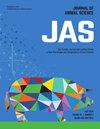In Vitro Fermentation Potential of Undigested Dietary Protein
IF 2.7
2区 农林科学
Q1 AGRICULTURE, DAIRY & ANIMAL SCIENCE
引用次数: 0
Abstract
This study aimed to investigate the in vitro fermentation potential of ileal digesta from pigs fed seven protein sources with different batches—maize germ meal (MGM), cottonseed meal (CSM), rapeseed cake (RSC), rapeseed meal (RSM), peanut meal (PM), soybean meal (SBM), and sunflower meal (SFM)—to assess their potential impact on hindgut protein fermentation, which can be harmful to animals. Ileal digesta samples were incubated with porcine faecal inoculum under N-free conditions, with whey protein isolate (WPI) as a control. Gas production (GP) resulting from protein fermentation was monitored over 48 hours and analysed using a modified biphasic model to assess substrate fermentation and microbiota turnover dynamics. Significant variations in fermentation characteristics, including maximum GP rates (Rmax), cumulative GP, and microbiota turnover slopes, were observed across the protein sources. Rmax values ranged from 16.8 ± 0.6 to 27.9 ± 0.8 mL/h for MGM and SFM, respectively compared to 12.5 ± 0.4 mL/h for WPI. Solubility and molecular mass analyses showed differences in the proportion of insoluble nitrogenous molecules and the distribution of soluble molecules, reflecting varying fermentability. Standardized hindgut fermentation potential differed significantly among the protein sources, with MGM exhibiting the highest potential (1.18 L/g dietary protein) and SBM the lowest (0.46 L/g dietary protein). These findings provide valuable insights into the differential accessibility of undigested protein to hindgut microbiota, contributing to more effective diet management and optimization of animal and human nutrition strategies.未消化饲粮蛋白质体外发酵潜力的研究
本研究旨在调查饲喂七种不同批次蛋白质来源--玉米胚芽粕(MGM)、棉籽粕(CSM)、菜籽饼(RSC)、菜籽粕(RSM)、花生粕(PM)、豆粕(SBM)和葵花籽粕(SFM)的猪的回肠消化液的体外发酵潜力,以评估它们对动物后肠蛋白质发酵的潜在影响,因为后肠蛋白质发酵可能对动物有害。在无氮(N)条件下,用猪粪便接种体培养回肠消化液样本,并用分离乳清蛋白(WPI)作为对照。在 48 小时内监测蛋白质发酵产生的气体(GP),并使用改进的双相模型进行分析,以评估基质发酵和微生物群更替动态。不同蛋白质来源的发酵特征存在显著差异,包括最大 GP 率(Rmax)、累积 GP 和微生物群周转斜率。MGM 和 SFM 的 Rmax 值分别为 16.8 ± 0.6 至 27.9 ± 0.8 mL/h,而 WPI 为 12.5 ± 0.4 mL/h。溶解度和分子质量分析表明,不溶性含氮分子的比例和可溶性分子的分布存在差异,这反映了不同的发酵性。不同蛋白质来源的标准化后肠发酵潜能值差异显著,其中 MGM 的潜能值最高(1.18 升/克日粮蛋白质),而 SBM 的潜能值最低(0.46 升/克日粮蛋白质)。这些发现为了解后肠微生物群对未消化蛋白质的不同利用率提供了宝贵的见解,有助于更有效地进行日粮管理以及优化动物和人类营养策略。
本文章由计算机程序翻译,如有差异,请以英文原文为准。
求助全文
约1分钟内获得全文
求助全文
来源期刊

Journal of animal science
农林科学-奶制品与动物科学
CiteScore
4.80
自引率
12.10%
发文量
1589
审稿时长
3 months
期刊介绍:
The Journal of Animal Science (JAS) is the premier journal for animal science and serves as the leading source of new knowledge and perspective in this area. JAS publishes more than 500 fully reviewed research articles, invited reviews, technical notes, and letters to the editor each year.
Articles published in JAS encompass a broad range of research topics in animal production and fundamental aspects of genetics, nutrition, physiology, and preparation and utilization of animal products. Articles typically report research with beef cattle, companion animals, goats, horses, pigs, and sheep; however, studies involving other farm animals, aquatic and wildlife species, and laboratory animal species that address fundamental questions related to livestock and companion animal biology will be considered for publication.
 求助内容:
求助内容: 应助结果提醒方式:
应助结果提醒方式:


